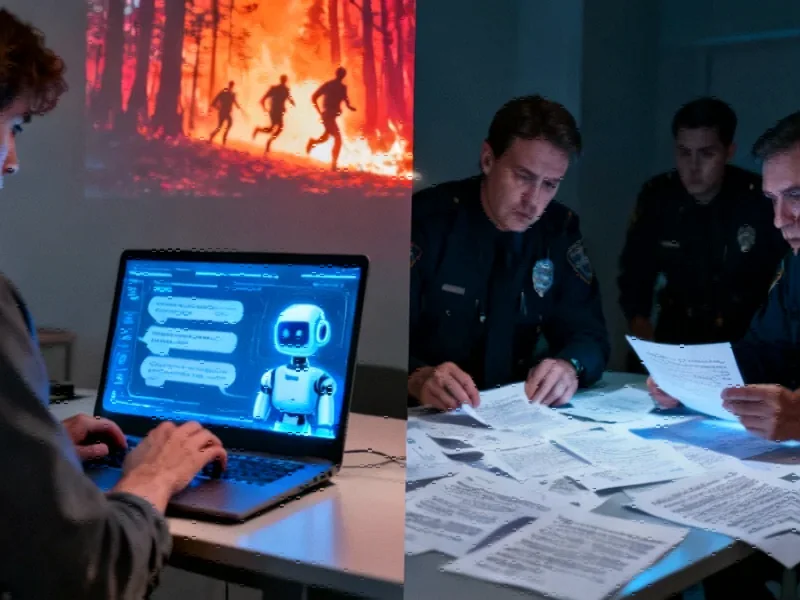The Unseen Witness: AI Conversations as Legal Evidence
In the digital age, your most candid business conversations might not be happening in boardrooms or email threads, but within AI chat interfaces. The recent Palisades Fire case, where prosecutors used ChatGPT logs to build an arson and murder case, demonstrates a seismic shift in how digital evidence is collected and interpreted. What began as a tool for productivity has quietly become a corporate confessional—capturing not just queries but intent, motivation, and strategic thinking in unprecedented detail.
Law enforcement’s ability to trace criminal intent through chatbot records establishes a new precedent that should concern every enterprise. Your organization’s AI interactions—whether discussing market strategies, venting about competitors, or brainstorming product launches—create a permanent record that could be subpoenaed or exposed in litigation. This represents a fundamental shift in how digital evidence is understood and utilized in legal proceedings.
Beyond Trade Secrets: The Full Spectrum of Corporate Exposure
While most companies focus on protecting traditional trade secrets, AI chat logs capture something more nuanced: the evolution of business strategy. These systems record not just what decisions were made, but how they were considered, debated, and refined. The contextual richness of these conversations—including abandoned ideas, competitive assessments, and internal frustrations—creates a comprehensive picture of corporate direction that rivals any strategic document.
Several AI chat logs becoming critical evidence in criminal investigations demonstrate how these systems capture mindset and motive with disturbing clarity. In the Palisades case, the suspect’s queries about fire liability and image generation of burning forests created a narrative trail that traditional digital forensics would have missed entirely.
The Security Paradox: Saying “No” Versus Managing Risk
Many security teams have responded to these risks by implementing blanket bans on AI tools, creating what I call the “Security Framework of No.” This approach misunderstands both human nature and modern technology. When employees encounter barriers to legitimate work tools, they don’t stop working—they find workarounds. The result isn’t increased security but decreased visibility as activity shifts to personal accounts and unauthorized platforms.
The banking and healthcare sectors, despite operating under stringent regulations, are demonstrating that it’s possible to say “yes” to AI innovation while maintaining security. They’re building what might be called the unseen backbone of AI infrastructure—systems that enable safe experimentation through proper guardrails and oversight.
Distributed Security: The New Model for AI Governance
Traditional centralized security models struggle with AI’s pervasive nature. A more effective approach involves distributed oversight—embedding security awareness and responsibility within each business unit. This doesn’t mean abandoning control, but rather creating a security presence that observes, guides, and educates in real-time.
This shift requires rethinking how we approach the cybersecurity landscape and its relationship to emerging technologies. Rather than blocking tools, we should focus on creating awareness of what constitutes risky behavior and establishing clear protocols for safe AI usage.
Building Guardrails: From Prevention to Enablement
The most forward-thinking organizations are shifting their security baseline from “no” to “yes, with guardrails.” This involves implementing systems for access control, auditability, model integrity, and human oversight. The SANS Institute Secure AI Blueprint outlines this approach through three pillars: Protect, Utilize, and Govern AI.
Critical to this framework is recognizing that prompt security updates and maintenance form just one part of a comprehensive AI security strategy. Organizations must also address data classification, usage policies, and monitoring systems specifically designed for AI interactions.
The Visibility Imperative: Knowing What You Don’t Know
When organizations block AI tools without providing alternatives, they create the worst of both worlds: continued usage through shadow IT combined with complete loss of visibility. Like teenagers finding ways around parental controls, employees will use whatever tools they need to accomplish their work. The security challenge isn’t preventing usage but ensuring it happens visibly and safely.
Recent industry developments in AI monitoring and compliance tools are making distributed oversight increasingly feasible. These systems can flag potentially problematic queries—whether related to data exposure, legal liability, or ethical concerns—without requiring a complete ban on AI usage.
The Future of AI Accountability
As AI systems become more sophisticated in detecting malicious intent—from foreign adversaries to domestic threats—their role in corporate accountability will only expand. Organizations must assume that their AI interactions could eventually be scrutinized by regulators, litigators, or law enforcement. This isn’t an argument against AI adoption, but for more thoughtful implementation.
The companies that will thrive in this new environment are those that embrace AI’s potential while building the governance structures to manage its risks. They recognize that, much like the dancing in Footloose, you can’t stop technological progress—but you can ensure it happens safely, visibly, and responsibly.
As AI continues to transform business operations, staying informed about market trends and security implications becomes increasingly critical for organizational leadership.
This article aggregates information from publicly available sources. All trademarks and copyrights belong to their respective owners.
Note: Featured image is for illustrative purposes only and does not represent any specific product, service, or entity mentioned in this article.


